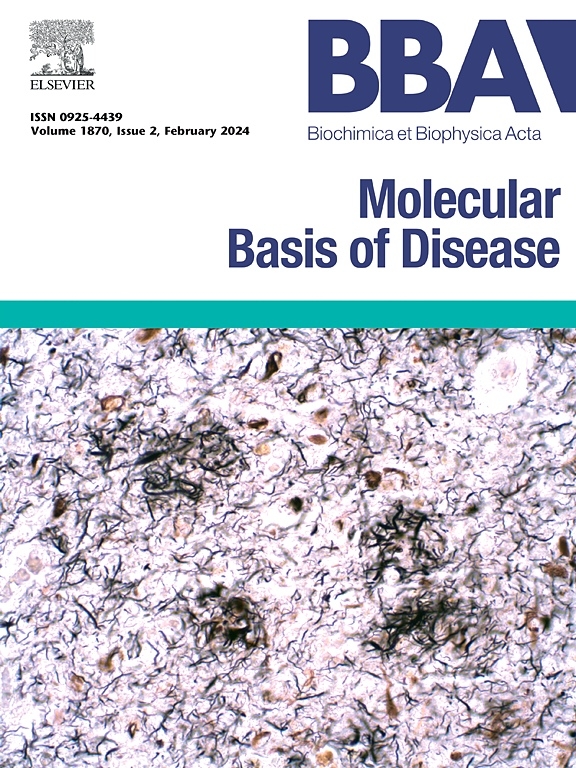tau病理学是酒精和其他药物引起的神经元损伤的相关因素吗?
IF 4.2
2区 生物学
Q2 BIOCHEMISTRY & MOLECULAR BIOLOGY
Biochimica et biophysica acta. Molecular basis of disease
Pub Date : 2025-09-22
DOI:10.1016/j.bbadis.2025.168059
引用次数: 0
摘要
无限制饮酒以及甲基苯丙胺(摇头丸)、阿片类药物、大麻和可卡因等其他物质在世界人口中引起了严重的健康问题。滥用这些物质会产生神经病理改变,从而导致认知能力下降和神经变性。这些药物引起的病理损伤类似于在神经系统疾病(NDs)中观察到的神经退行性改变,包括阿尔茨海默病(AD)、帕金森病(PD)等。这些疾病的一个重要特征是神经元内蛋白的聚集和神经元细胞骨架的失调。在此背景下,微管相关蛋白(MAP) tau蛋白的毒性修饰引起了对药物和酒精滥用研究的新兴趣。Tau可以经历不同的病理变化,其异常磷酸化和截断状态与NDs有关。这些修饰产生脱离微管结构,影响轴突运输和突触可塑性。目前的研究表明,酒精和药物滥用可能影响tau磷酸化背后的机制,诱导激酶/磷酸酶活性失调和毒性tau积累。这些改变可能是导致药物滥用引起的认知能力下降和神经变性的关键因素。因此,了解酒精和其他药物如何通过诱导tau病理导致神经元损伤是至关重要的。这一知识可以产生新的策略和生物医学目标,以减少药物滥用引起的成瘾消费、神经变性和认知能力下降。本文章由计算机程序翻译,如有差异,请以英文原文为准。
Is tau pathology a relevant factor in neuronal damage induced by alcohol and other drugs?
Unrestricted alcohol consumption and other substances like methamphetamine (ecstasy), opioids, cannabis, and cocaine have generated serious health concerns in the world population. The abusive use of these substances produces neuropathological alterations that could lead to cognitive decline and neurodegeneration. Pathological damage generated by these drugs resembles neurodegenerative changes observed in neurological disorders (NDs), including Alzheimer's disease (AD), Parkinson's disease (PD), and others. One of the relevant elements distinguished in these diseases is the aggregation of intraneuronal proteins and deregulation of the neuronal cytoskeleton. In this context, the toxic modification of tau protein, a microtubule-associated protein (MAP), has raised new interest in drug and alcohol abuse research. Tau can undergo different pathological changes in which its anomalous phosphorylation and truncation state are relevant for NDs. These modifications produce a detachment from microtubule structures, affecting axonal transport and synaptic plasticity.
Current studies suggest that alcohol and drug abuse may affect the mechanisms behind tau phosphorylation, inducing dysregulation of kinase/phosphatase activities and toxic tau accumulation. These alterations could be a key element that contributes to cognitive decline and neurodegeneration caused by substance abuse.
Therefore, it is pivotal to understand how alcohol and other drugs contribute to neuronal damage by inducing tau pathology. This knowledge could generate new strategies and biomedical targets to reduce addictive consumption, neurodegeneration, and cognitive decline produced by substance abuse.
求助全文
通过发布文献求助,成功后即可免费获取论文全文。
去求助
来源期刊
CiteScore
12.30
自引率
0.00%
发文量
218
审稿时长
32 days
期刊介绍:
BBA Molecular Basis of Disease addresses the biochemistry and molecular genetics of disease processes and models of human disease. This journal covers aspects of aging, cancer, metabolic-, neurological-, and immunological-based disease. Manuscripts focused on using animal models to elucidate biochemical and mechanistic insight in each of these conditions, are particularly encouraged. Manuscripts should emphasize the underlying mechanisms of disease pathways and provide novel contributions to the understanding and/or treatment of these disorders. Highly descriptive and method development submissions may be declined without full review. The submission of uninvited reviews to BBA - Molecular Basis of Disease is strongly discouraged, and any such uninvited review should be accompanied by a coverletter outlining the compelling reasons why the review should be considered.

 求助内容:
求助内容: 应助结果提醒方式:
应助结果提醒方式:


